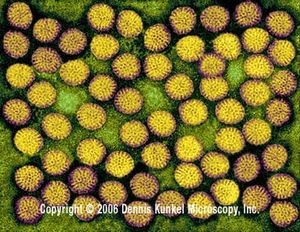Reoviridae

Baltimore Classification
Higher order taxa
Viruses; dsRNA viruses; Reoviridae
Genera
Orthoreovirus, Rotavirus, Orbivirus, Coltivirus, Aquareovirus, Seadornavirus, Cypovirus, Idnoreovirus, Fijivirus, Phytoreovirus, Oryzavirus, Mycoreovirus
Description and Significance
Reoviruses, or Respiratory Enteric Orphan viruses, infect invertebrates, vertebrates, and plants. In vertebrates, reoviruses cause infections of the respiratory and gastrointestinal tracts. Rotaviruses, part of the Reovirus family, are a major cause of infant deaths in the developing world, killing over 800,000 children under the age of 2 each year. Originally, reoviruses were classified as echoviruses, in the family Picornaviridae. (sources: Microbiology @ Leicester, Wong)
Genome Structure
The reovirus genome is monomeric and consist of ten to twelve segments (depending on the genus) of linear, double-stranded RNA. The complete genome is 18200-30500 nucleotides long. There is a methylated nucleotide cap on the 5'-terminus. Each virion contains a full-length copy of the genome. (source: ICTVdB)
Virion Structure of a Reovirus
Reovirus virions are non-enveloped and consist of a capsid, a core, and a nucleoprotein complex. The capsid is 60-80nm in diameter and is icosahedral. The virion has a double protein shell. Virus particles can be in inclusion bodies that are not occluded and contain one nucleocapsid, or they can be occluded by protein bodies. (sources: ICTVdB, Microbiology @ Leicester)
Reproduction Cycle of a Reovirus in a Host Cell
Reovirus virions attach to the surface of a cell, are internalized, and are partially uncoated by endolysosomes in the cytoplasm. The virions do not fully uncoat due to a resistance to protease digestion, which prevents them from being destroyed by the host cell. Replication takes place in the cytoplasm of the host cell. Early transcription takes place inside the virion, with the synthesis of positive-sense mRNAs. The mRNAs are capped inside the virion and are released into the cytoplasm, where they are used as templates for the synthesis of negative-sense RNA. Virions are assembled in the cytoplasm 6-7 hours after infection and are released when the cell lyses. (sources: Bernstein, Microbiology @ Leicester)
Viral Ecology & Pathology
Reoviruses infect a wide variety of organisms through equally varied vectors. For more information, see Orthoreovirus and Rotavirus.
References
ICTVdB - The Universal Virus Database, version 4. http://www.ncbi.nlm.nih.gov/ICTVdb/ICTVdB/
